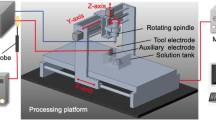Abstract
The need for products containing micro-features has shown a remarkably and steady growth in many fields of application in recent years. For the development of micro-feature devices, one of the most important technologies is ECMM (ElectroChemical Micro Machining). In numerous non-conventional micro machining, ECMM has merits such as leaving no residual stress and lower surface roughness on machined products and also it is the absence of heat-affected zone around the cutting area. ECMM is one of the most appropriate machining method for Invar alloy micro machining, and little research has focused on the micro groove machining on Invar film. In this paper, the machining characteristics of ECMM for Invar thin film with WC rod electrode is investigated. By controlling applied voltage, machining time and pulse condition, the machined area and depth of groove on Invar film can be controlled. These methods can machine micro groove on thin Invar film, which is very difficult to do by conventional machining method, because the Invar film thickness is only 30 µm. With the increase of applied voltage and machining time, the machined depth and range of machined area became larger. Experimental results show that 60 % duty factor value is suitable for satisfying both machining rate and accuracy. And the surface quality characteristics of the machined area are investigated. For fabrication precise surface Invar film or Invar devices, high frequency condition is essential. The purpose of this study was to confirm possibilities of making grooving pattern on thin Invar film in micro size and cutting invar thin film using ECMM.






Similar content being viewed by others
References
Das AK, Saha P (2013) Analysis on fabrication of micro-tools by micro-electrochemical machining process. Int J Nano-Manuf 9(1):66–76
Das AK, Saha P (2014) Fabrication of cylindrical micro tools by micro electrochemical form turning operation. Proc Inst Mech Eng Part B J Eng Manuf 228(1):74–81
Dhobe SD, Doloi B, Bhattacharyya B (2011) Surface characteristics of ECMed titanium work samples for bio medical applications. Int J Adv Manuf Technol 55(1–4):178–188
Fan ZJ, Zhao GG, Zhang LJ (2012) Design of analysis-based cathode with complex groove. J China Ordnance 8(1):31–34
Jain VK, Chauhan AS, Thakur A, Sidpara A (2013) Fabrications of micro tools and micro patterns by electrochemical micromachining and some investigation into overpotential. J Adv Manuf Syst 12(02):85–106
Klocke F, Zeis M, Klink A (2012) Technological and economical capabilities of manufacturing titaniumand nickel-based alloys via electrochemical machining (ECM). Key Eng Mater 504:1237–1242
Labib AW, Keasberry VJ, Atkinson J, Frost HW (2011) Towards next generation electrochemical machining controllers: a fuzzy logic control approach to ECM. Expert Syst Appl 38(6):7486–7493
Liu CW, Chen YL, Wu WC (2012) Integrated development of a modularized ECM manufacturing system based on the reconfigurable manufacturing system concept. Key Eng Mater 516(18):102–107
Marla D, Joshi SS, Mitra SK (2008) Modeling of electrochemical micromachining: comparison to experiments. J Micro/Nanolithogr MEMS MOEMS 7(3):033015
McGeough JA (1988) Advanced methods of machining, 1st edn. Chapman and Hall, USA
Park NJ, Oh MH, Kim SM (2000) Effects of texture on the etching property of Fe-36 % Ni Invar sheets. Met Mater 6(1):51–56
Rajurkar KP, Zhu D, McGeough JA, Kokaz J, De Silva A (1999) New development in electrochemical machining. CIRP Ann Manuf Technol 48(2):567–579
Shokrani A, Dhokia V, Newman ST (2012) Environmentally conscious machining of difficult-to-machine materials with regard to cutting fluids. Int J Mach Tools Manuf 57:83–101
Tlusty G (1999) Manufacturing processes and equipment. Prentice-Hall Inc, USA
Walther B, Schilm J, Michaelis A, Lohrengel M (2007) Electrochemical dissolution of hard metal alloys. Electrochim Acta 52(27):7732–7737
Xu ZY, Xu Q, Zhu D, Gong T (2013) A high efficiency electrochemical machining method of blisk channels. CIRP Ann Manuf Technol 62:187–190
Zhao Y, Sato YS, Kokawa H, Wu AP (2011) Microstructure and properties of friction stir welded high strength Fe-36 wt% Ni alloy. Mater Sci Eng 528(25–26):7768–7773
Acknowledgments
This work was supported by the National Research Foundation of Korea (NRF) grant funded by the Korea government (MSIP) (No. 2015R1A2A1A15054116).
Author information
Authors and Affiliations
Corresponding author
Rights and permissions
About this article
Cite this article
Choi, WK., Kim, SH. & Lee, ES. Electrochemical micro machining characteristics of Fe64Ni36 invar film using micro WC rod electrode. Microsyst Technol 23, 405–410 (2017). https://doi.org/10.1007/s00542-016-3076-z
Received:
Accepted:
Published:
Issue Date:
DOI: https://doi.org/10.1007/s00542-016-3076-z




